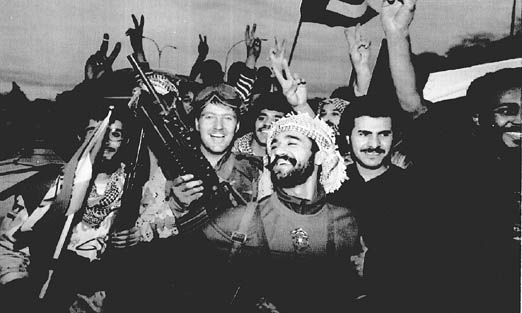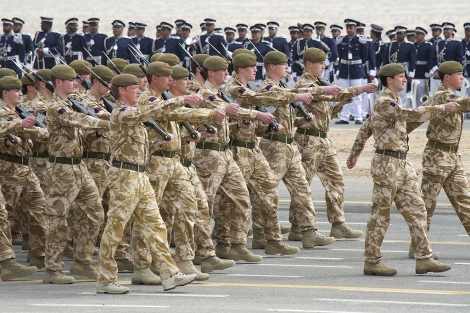On 28 February 1991, troops from a US-led coalition declared a cease-fire after driving Iraqi troops from Kuwait, which had invaded half a year before, thus ending the Gulf War. Also known as Operation Desert Storm, the war lasted only 41 days because of the overwhelming superiority of the allied army.
In total, it is estimated that died as a result of fighting some 3,000 civilians and 10,000 Iraqi soldiers on the one hand, and about 500 soldiers of the international coalition that joined thirty countries, including Spain and the main Arab World powers like Saudi Arabia, Egypt and Syria.
The war began on the night of January 17 with a bombardment of Iraqi military positions, and some key infrastructure. In total, jumped on the Arab country about 90,000 tons of explosives for over a month. On 23 February the ground operation launched to liberate Kuwait, which had about 150,000 soldiers.
Upon its entry into Kuwait, just found some resistance from Iraqi troops who surrendered after brief fighting. However, the conflict stems from the invasion of Kuwait from Saddam Hussein on August 2, 1991. Iraq was then an exhausted and impoverished country after nearly a decade of war against Iran.
The "Raise 'Iraqi believed that his country had paid a high price to curb the expansionist ambitions of Khomeini's revolutionary Iran, and called for greater financial assistance from Saudi Arabia. After failing this, Hussein chose to take the prolific oil wells of the tiny emirate. Unlike the Iraq War of 2003, President George Bush spent several months building a broad military coalition and the necessary consensus within the international community to get the stamp of legitimacy of the Security Council of United Nations .
Saddam tried to break the international coalition inserting the conflict between Israelis and Palestinians in the war by launching Scud missiles against Israel. Two Israelis were killed and 230 wounded, but the Jewish state did not fall for provocation and did not respond to attacks. The concern in the U.S.
and in Israel was that Saddam could include chemical or biological warheads on missiles, but he did in the absence of these weapons. Indeed, the fact that it had launched a program to manufacture weapons of mass destruction that Saddam Hussein wanted to eliminate was the motive for the international community imposed a harsh regime of sanctions, which would continue until the beginning of the War Iraq, more than a decade later.
By some estimates, up to a million children have died from malnutrition. None of the major players in that conflict continues to occupy positions of power two decades later. Gen. Norman Schwarzkopf, the highest military authority of the offensive, retired a few months after the war. And George Bush could not get his election to lose to Bill Clinton.
With respect to Saddam Hussein, was able to stay in power despite his humiliating defeat. His army had been only partially damaged, or who used it to suppress the Shiite uprising in the south. Bush decided not to come to Baghdad with tanks, and offer a second chance to rejoin the international community.
But Saddam, proud and defiant, the squandered. Pulse with the U.S. remained until the 11-S pushed Bush Jr. to finish the task that his father had left socks, and cruel tyrant was eventually executed after a trial. 


In total, it is estimated that died as a result of fighting some 3,000 civilians and 10,000 Iraqi soldiers on the one hand, and about 500 soldiers of the international coalition that joined thirty countries, including Spain and the main Arab World powers like Saudi Arabia, Egypt and Syria.
The war began on the night of January 17 with a bombardment of Iraqi military positions, and some key infrastructure. In total, jumped on the Arab country about 90,000 tons of explosives for over a month. On 23 February the ground operation launched to liberate Kuwait, which had about 150,000 soldiers.
Upon its entry into Kuwait, just found some resistance from Iraqi troops who surrendered after brief fighting. However, the conflict stems from the invasion of Kuwait from Saddam Hussein on August 2, 1991. Iraq was then an exhausted and impoverished country after nearly a decade of war against Iran.
The "Raise 'Iraqi believed that his country had paid a high price to curb the expansionist ambitions of Khomeini's revolutionary Iran, and called for greater financial assistance from Saudi Arabia. After failing this, Hussein chose to take the prolific oil wells of the tiny emirate. Unlike the Iraq War of 2003, President George Bush spent several months building a broad military coalition and the necessary consensus within the international community to get the stamp of legitimacy of the Security Council of United Nations .
Saddam tried to break the international coalition inserting the conflict between Israelis and Palestinians in the war by launching Scud missiles against Israel. Two Israelis were killed and 230 wounded, but the Jewish state did not fall for provocation and did not respond to attacks. The concern in the U.S.
and in Israel was that Saddam could include chemical or biological warheads on missiles, but he did in the absence of these weapons. Indeed, the fact that it had launched a program to manufacture weapons of mass destruction that Saddam Hussein wanted to eliminate was the motive for the international community imposed a harsh regime of sanctions, which would continue until the beginning of the War Iraq, more than a decade later.
By some estimates, up to a million children have died from malnutrition. None of the major players in that conflict continues to occupy positions of power two decades later. Gen. Norman Schwarzkopf, the highest military authority of the offensive, retired a few months after the war. And George Bush could not get his election to lose to Bill Clinton.
With respect to Saddam Hussein, was able to stay in power despite his humiliating defeat. His army had been only partially damaged, or who used it to suppress the Shiite uprising in the south. Bush decided not to come to Baghdad with tanks, and offer a second chance to rejoin the international community.
But Saddam, proud and defiant, the squandered. Pulse with the U.S. remained until the 11-S pushed Bush Jr. to finish the task that his father had left socks, and cruel tyrant was eventually executed after a trial.



- veinte diosas|one girl 20 looks (25/02/2011)
- Versatile Vixen Editorials - Anne Vyalitsyna is Both Seductive and Sweet in Veinte Diosas (VIDEO) (27/02/2011)
- Blackuary Veinte - 03AB - Gay = New Black... (20/02/2011)
- 20 km and a different world! - Castellammare del Golfo, Italy (19/02/2011)
- Blog of the B**ch... and no..that' not Beech! - Castellammare del Golfo, Italy (12/02/2011)
You have provided very good information through blog and it is very important. I was searching for similar information for a long time, which is received through your blog.Thank you so much.
ReplyDeleteBanes Pincode
Many people will get lot of benefits by reading such kind of informational stuff .Thank you so much for this .
ReplyDeletebijnor postal code